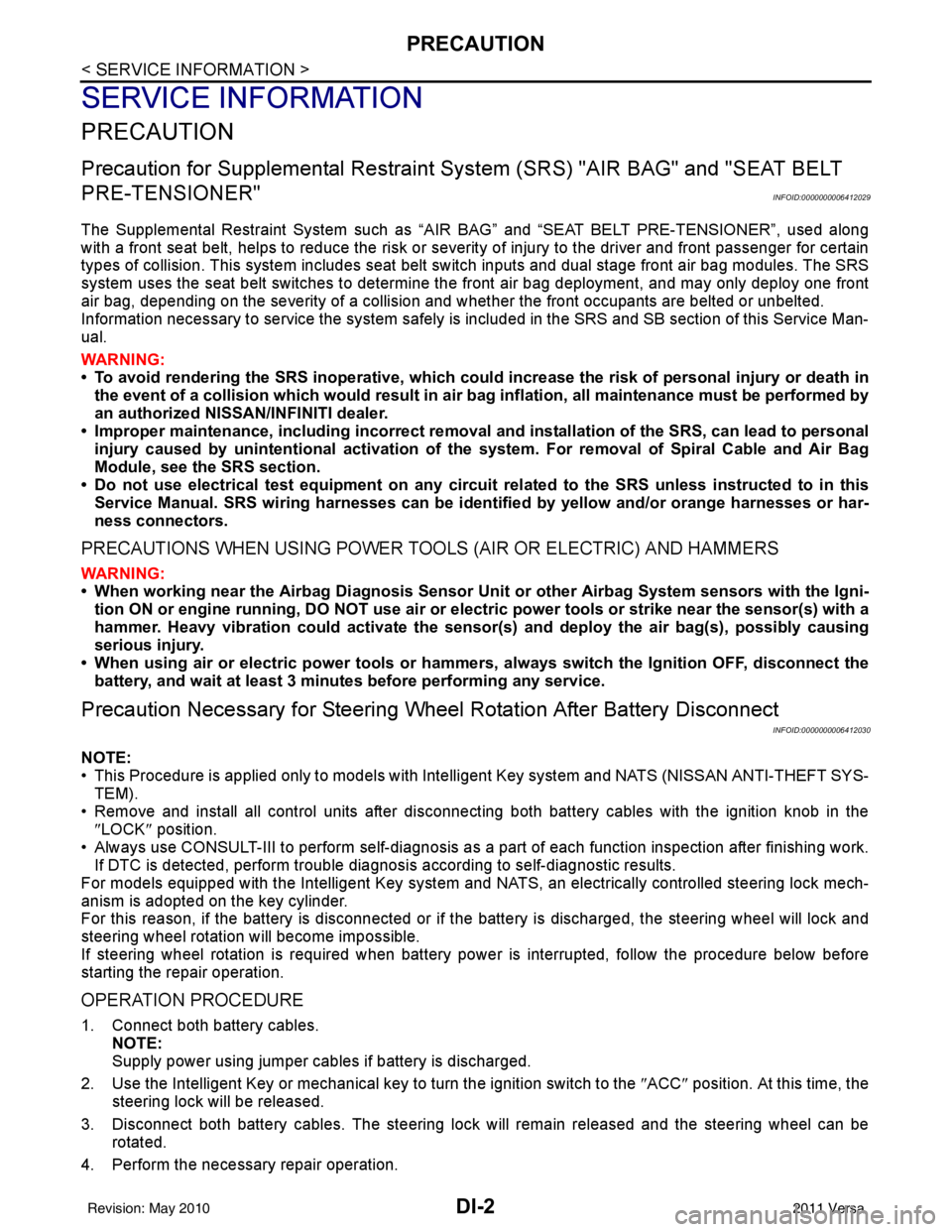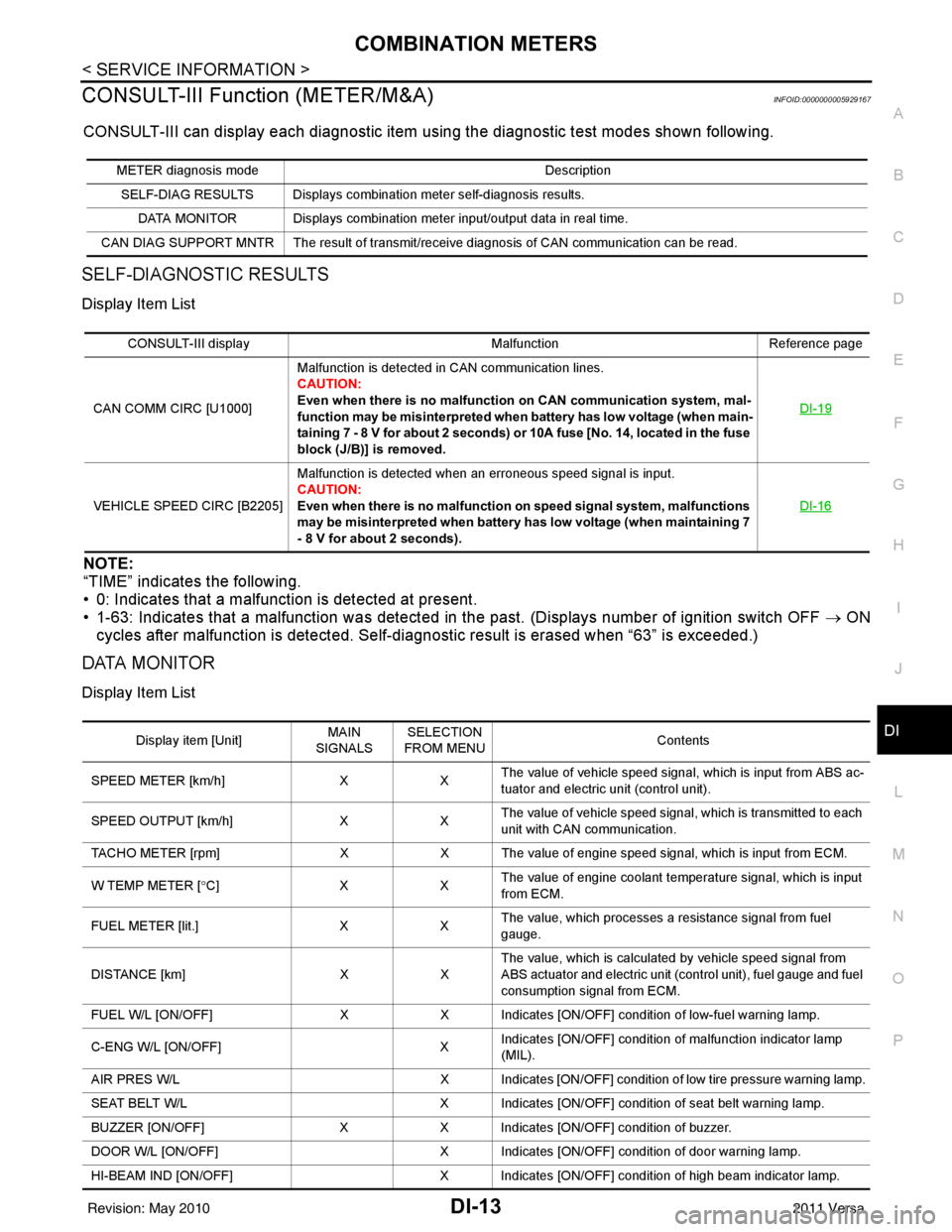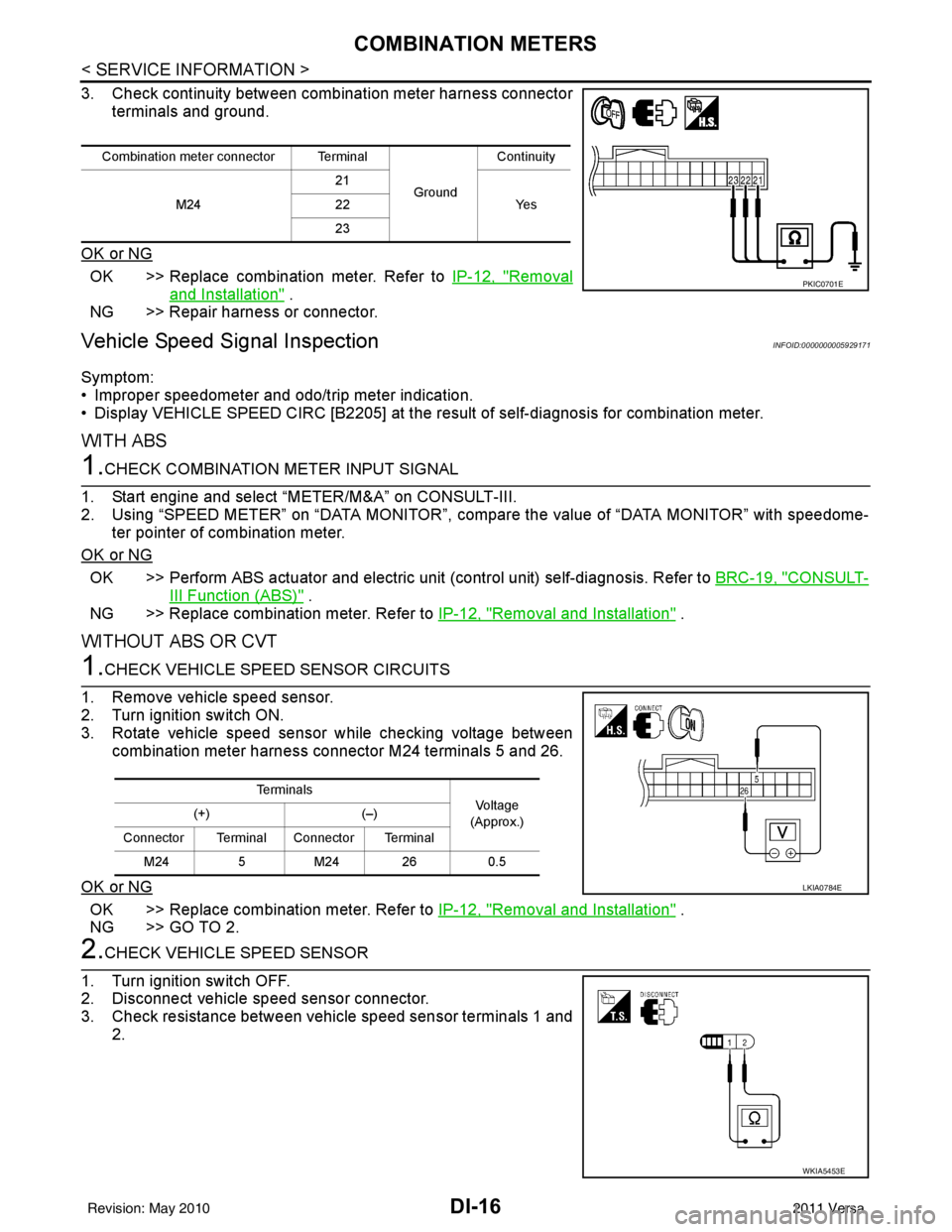2011 NISSAN TIIDA remove engine
[x] Cancel search: remove enginePage 1227 of 3787
![NISSAN TIIDA 2011 Service Repair Manual CVT-172
< SERVICE INFORMATION >[RE0F08B]
OIL PAN
OIL PAN
Exploded ViewINFOID:0000000006413338
Removal and InstallationINFOID:0000000006413339
REMOVAL
1. Remove engine under cover.
2. Remove drain plug NISSAN TIIDA 2011 Service Repair Manual CVT-172
< SERVICE INFORMATION >[RE0F08B]
OIL PAN
OIL PAN
Exploded ViewINFOID:0000000006413338
Removal and InstallationINFOID:0000000006413339
REMOVAL
1. Remove engine under cover.
2. Remove drain plug](/manual-img/5/57396/w960_57396-1226.png)
CVT-172
< SERVICE INFORMATION >[RE0F08B]
OIL PAN
OIL PAN
Exploded ViewINFOID:0000000006413338
Removal and InstallationINFOID:0000000006413339
REMOVAL
1. Remove engine under cover.
2. Remove drain plug from oil pan and then drain the CVT fluid.
3. Remove oil pan bolts ( ), and then remove oil pan and oil pan
gasket.
• : Front
4. Remove magnets from oil pan.
INSTALLATION
Note the following, and install in the reverse order of removal.
CAUTION:
1. Transaxle assembly 2. Oil pan bolt 3. Drain plug
4. Drain plug gasket 5. Oil pan 6. Oil pan gasket
7. Magnet
AWDIA0875GB
AWDIA0876ZZ
Revision: May 2010 2011 Versa
Page 1230 of 3787
![NISSAN TIIDA 2011 Service Repair Manual CVT OIL WARMER SYSTEMCVT-175
< SERVICE INFORMATION > [RE0F08B]
D
E
F
G H
I
J
K L
M A
B
CVT
N
O P
CVT OIL WARMER SYSTEM
WATER HOSE
WATER HOSE : Exploded ViewINFOID:0000000006068646
WATER HOSE : Removal NISSAN TIIDA 2011 Service Repair Manual CVT OIL WARMER SYSTEMCVT-175
< SERVICE INFORMATION > [RE0F08B]
D
E
F
G H
I
J
K L
M A
B
CVT
N
O P
CVT OIL WARMER SYSTEM
WATER HOSE
WATER HOSE : Exploded ViewINFOID:0000000006068646
WATER HOSE : Removal](/manual-img/5/57396/w960_57396-1229.png)
CVT OIL WARMER SYSTEMCVT-175
< SERVICE INFORMATION > [RE0F08B]
D
E
F
G H
I
J
K L
M A
B
CVT
N
O P
CVT OIL WARMER SYSTEM
WATER HOSE
WATER HOSE : Exploded ViewINFOID:0000000006068646
WATER HOSE : Removal and InstallationINFOID:0000000006068647
REMOVAL
WARNING:
Never remove the radiator cap when the engine is hot. Serious burns could occur from high pressure
coolant escaping from the radiator.
CAUTION:
Perform this step engine is cold.
1. Remove air duct (inlet). Refer to EM-135, "
Component".
2. Remove hose clamps, and remove CVT water hose A.
3. Remove hose clamps, and remove CVT water hose B.
4. Remove hose clamps, and remove CVT water hose C.
5. Remove CVT water tube.
INSTALLATION
Installation is in the reverse order of removal.
1. Hose clamp 2. CVT water hose C3. CVT water tube
4. CVT water hose B 5. Transaxle assembly6. CVT oil warmer
7. CVT water hose A
A. Water pump B. Water inlet-outlet
Refer to GI-8, "
Component" for symbols in the figure.
JSDIA1290GB
Revision: May 2010 2011 Versa
Page 1234 of 3787
![NISSAN TIIDA 2011 Service Repair Manual CVT OIL WARMER SYSTEMCVT-179
< SERVICE INFORMATION > [RE0F08B]
D
E
F
G H
I
J
K L
M A
B
CVT
N
O P
CVT FLUID COOLER HOSE : InspectionINFOID:0000000006068651
INSPECTION AFTER INSTALLATION
Check for CVT f NISSAN TIIDA 2011 Service Repair Manual CVT OIL WARMER SYSTEMCVT-179
< SERVICE INFORMATION > [RE0F08B]
D
E
F
G H
I
J
K L
M A
B
CVT
N
O P
CVT FLUID COOLER HOSE : InspectionINFOID:0000000006068651
INSPECTION AFTER INSTALLATION
Check for CVT f](/manual-img/5/57396/w960_57396-1233.png)
CVT OIL WARMER SYSTEMCVT-179
< SERVICE INFORMATION > [RE0F08B]
D
E
F
G H
I
J
K L
M A
B
CVT
N
O P
CVT FLUID COOLER HOSE : InspectionINFOID:0000000006068651
INSPECTION AFTER INSTALLATION
Check for CVT fluid leakage and check CVT fluid level. Refer to CVT-14, "Checking CVT Fluid".
CVT OIL WARMER
CVT OIL WARMER : Exploded ViewINFOID:0000000006068652
CVT OIL WARMER : Removal and InstallationINFOID:0000000006068653
REMOVAL
WARNING:
Never remove the radiator cap when the engine is hot. Serious burns could occur from high pressure
coolant escaping from the radiator.
CAUTION:
Perform this step engine is cold.
1. Remove CVT water hose from CVT oil warmer. Refer to CVT-175, "
WATER HOSE : Exploded View".
2. Remove CVT fluid cooler hose from CVT oil warmer. Refer to CVT-177, "
CVT FLUID COOLER HOSE :
Exploded View".
3. Remove CVT oil warmer.
4. Remove bracket.
INSTALLATION
Installation is in the reverse order of removal.
CVT OIL WARMER : InspectionINFOID:0000000006068654
INSPECTION AFTER INSTALLATION
• Check for CVT fluid leakage and check CVT fluid level. Refer to CVT-14, "Checking CVT Fluid".
• Start and warm up the engine. Visually check that there is no leakage of engine coolant and CVT fluid.
1. CVT oil warmer2. Bracket3. Transaxle assembly
Refer to GI-8, "
Component" for symbols in the figure.
JPDIA0725GB
Revision: May 2010 2011 Versa
Page 1235 of 3787
![NISSAN TIIDA 2011 Service Repair Manual CVT-180
< SERVICE INFORMATION >[RE0F08B]
TRANSAXLE ASSEMBLY
TRANSAXLE ASSEMBLY
Removal and InstallationINFOID:0000000005928976
COMPONENTS
REMOVAL
WARNING:
Never remove the radiator cap when the engine NISSAN TIIDA 2011 Service Repair Manual CVT-180
< SERVICE INFORMATION >[RE0F08B]
TRANSAXLE ASSEMBLY
TRANSAXLE ASSEMBLY
Removal and InstallationINFOID:0000000005928976
COMPONENTS
REMOVAL
WARNING:
Never remove the radiator cap when the engine](/manual-img/5/57396/w960_57396-1234.png)
CVT-180
< SERVICE INFORMATION >[RE0F08B]
TRANSAXLE ASSEMBLY
TRANSAXLE ASSEMBLY
Removal and InstallationINFOID:0000000005928976
COMPONENTS
REMOVAL
WARNING:
Never remove the radiator cap when the engine is hot. Serious burns coul
d occur from high pressure
coolant escaping from the radiator.
CAUTION:
• Perform this step engine is cold.
• When replacing TCM and transaxle assembly as a set, replace transaxle assembly first and then replace TCM. Refer to CVT-8, "
Service After Replacing TCM and Transaxle Assembly".
1. Remove the engine and transaxle as an assembly. Refer to EM-197, "
Removal and Installation".
1. CVT fluid level gauge2. CVT fluid charging pipe 3. O-ring
4. Copper washer 5. Fluid cooler tube6. Transaxle assembly
7. Engine mounting bracket (LH) 8. Air breather hose A. Refer to "INSTALLATION".
WCIA0614E
Revision: May 2010 2011 Versa
Page 1236 of 3787
![NISSAN TIIDA 2011 Service Repair Manual TRANSAXLE ASSEMBLYCVT-181
< SERVICE INFORMATION > [RE0F08B]
D
E
F
G H
I
J
K L
M A
B
CVT
N
O P
2. Disconnect the primary speed sensor (A) and the secondary
speed sensor connector (B) and CVT unit conn NISSAN TIIDA 2011 Service Repair Manual TRANSAXLE ASSEMBLYCVT-181
< SERVICE INFORMATION > [RE0F08B]
D
E
F
G H
I
J
K L
M A
B
CVT
N
O P
2. Disconnect the primary speed sensor (A) and the secondary
speed sensor connector (B) and CVT unit conn](/manual-img/5/57396/w960_57396-1235.png)
TRANSAXLE ASSEMBLYCVT-181
< SERVICE INFORMATION > [RE0F08B]
D
E
F
G H
I
J
K L
M A
B
CVT
N
O P
2. Disconnect the primary speed sensor (A) and the secondary
speed sensor connector (B) and CVT unit connector (C). Refer
to CVT-9, "
Removal and Installation Procedure for CVT Unit
Connector".
3. Remove the harness from the transaxle.
4. Remove the four drive plate to torque converter nuts. NOTE:
Rotate the crankshaft clockwise as viewed from front of engine
for access to drive plate to torque converter nuts.
5. Put matching marks on the drive plate and torque converter alignment stud. CAUTION:
For matching marks, use paint. Never dama ge the drive plate or torque converter.
6. Remove the transaxle to engine and engine to transaxle bolts.
7. Separate the transaxle from the engine.
8. If necessary, remove the following from the transaxle: • CVT fluid charging pipe
• Engine mounting bracket (LH)
• Fluid cooler tubes
• Air breather hose
• Any necessary brackets
INSTALLATION
Installation is in the reverse order of removal.
CAUTION:
• When replacing an engine or transmission you must make sure any dowels are installed correctlyduring re-assembly.
• Improper alignment caused by missing dowels may cause vibration, oil leaks or breakage of drive train components.
• Do not reuse O-rings and copper washers.
• When turning crankshaft, turn it clockwise as viewed from the front of the engine.
• When tightening the nuts for the torque converter while securing the crankshaft pulley bolt, be sure
to confirm the tightening torque of the crankshaft pulley bolt. Refer to EM-159
.
• After converter is installed to drive plate, ro tate crankshaft several turns to check that transaxle
rotates freely without binding.
AWDIA0661GB
WCIA0616E
Revision: May 2010 2011 Versa
Page 1241 of 3787

DI-2
< SERVICE INFORMATION >
PRECAUTION
SERVICE INFORMATION
PRECAUTION
Precaution for Supplemental Restraint System (SRS) "AIR BAG" and "SEAT BELT
PRE-TENSIONER"
INFOID:0000000006412029
The Supplemental Restraint System such as “A IR BAG” and “SEAT BELT PRE-TENSIONER”, used along
with a front seat belt, helps to reduce the risk or severity of injury to the driver and front passenger for certain
types of collision. This system includes seat belt switch inputs and dual stage front air bag modules. The SRS
system uses the seat belt switches to determine the front air bag deployment, and may only deploy one front
air bag, depending on the severity of a collision and w hether the front occupants are belted or unbelted.
Information necessary to service the system safely is included in the SRS and SB section of this Service Man-
ual.
WARNING:
• To avoid rendering the SRS inopera tive, which could increase the risk of personal injury or death in
the event of a collision which would result in air bag inflation, all maintenance must be performed by
an authorized NISSAN/INFINITI dealer.
• Improper maintenance, including in correct removal and installation of the SRS, can lead to personal
injury caused by unintent ional activation of the system. For re moval of Spiral Cable and Air Bag
Module, see the SRS section.
• Do not use electrical test equipmen t on any circuit related to the SRS unless instructed to in this
Service Manual. SRS wiring harn esses can be identified by yellow and/or orange harnesses or har-
ness connectors.
PRECAUTIONS WHEN USING POWER TOOLS (AIR OR ELECTRIC) AND HAMMERS
WARNING:
• When working near the Airbag Diagnosis Sensor Unit or other Airbag System sensors with the Igni-
tion ON or engine running, DO NOT use air or electri c power tools or strike near the sensor(s) with a
hammer. Heavy vibration could activate the sensor( s) and deploy the air bag(s), possibly causing
serious injury.
• When using air or electric power tools or hammers , always switch the Ignition OFF, disconnect the
battery, and wait at least 3 minu tes before performing any service.
Precaution Necessary for Steering W heel Rotation After Battery Disconnect
INFOID:0000000006412030
NOTE:
• This Procedure is applied only to models with Intelligent Key system and NATS (NISSAN ANTI-THEFT SYS-
TEM).
• Remove and install all control units after disconnecting both battery cables with the ignition knob in the
″LOCK ″ position.
• Always use CONSULT-III to perform self-diagnosis as a part of each function inspection after finishing work.
If DTC is detected, perform trouble diagnosis according to self-diagnostic results.
For models equipped with the Intelligent Key system and NATS, an electrically controlled steering lock mech-
anism is adopted on the key cylinder.
For this reason, if the battery is disconnected or if the battery is discharged, the steering wheel will lock and
steering wheel rotation will become impossible.
If steering wheel rotation is required when battery pow er is interrupted, follow the procedure below before
starting the repair operation.
OPERATION PROCEDURE
1. Connect both battery cables. NOTE:
Supply power using jumper cables if battery is discharged.
2. Use the Intelligent Key or mechanical key to turn the ignition switch to the ″ACC ″ position. At this time, the
steering lock will be released.
3. Disconnect both battery cables. The steering lock will remain released and the steering wheel can be rotated.
4. Perform the necessary repair operation.
Revision: May 2010 2011 Versa
Page 1252 of 3787

COMBINATION METERSDI-13
< SERVICE INFORMATION >
C
DE
F
G H
I
J
L
M A
B
DI
N
O P
CONSULT-III Function (METER/M&A)INFOID:0000000005929167
CONSULT-III can display each diagnostic item us ing the diagnostic test modes shown following.
SELF-DIAGNOSTIC RESULTS
Display Item List
NOTE:
“TIME” indicates the following.
• 0: Indicates that a malfunction is detected at present.
• 1-63: Indicates that a malfunction was detected in the past. (Displays number of ignition switch OFF → ON
cycles after malfunction is detected. Self-di agnostic result is erased when “63” is exceeded.)
DATA MONITOR
Display Item List
METER diagnosis mode Description
SELF-DIAG RESULTS Displays combination meter self-diagnosis results. DATA MONITOR Displays combination meter input/output data in real time.
CAN DIAG SUPPORT MNTR The result of transmit/receive diagnosis of CAN communication can be read.
CONSULT-III display MalfunctionReference page
CAN COMM CIRC [U1000] Malfunction is detected in CAN communication lines.
CAUTION:
Even when there is no malfuncti
on on CAN communication system, mal-
function may be misinterpreted when battery has low voltage (when main-
taining 7 - 8 V for about 2 seconds) or 10A fuse [No. 14, located in the fuse
block (J/B)] is removed. DI-19
VEHICLE SPEED CIRC [B2205]
Malfunction is detected when an erroneous speed signal is input.
CAUTION:
Even when there is no malfunction
on speed signal system, malfunctions
may be misinterpreted when battery has low voltage (when maintaining 7
- 8 V for about 2 seconds). DI-16
Display item [Unit]
MAIN
SIGNALS SELECTION
FROM MENU Contents
SPEED METER [km/h] XXThe value of vehicle speed signa
l, which is input from ABS ac-
tuator and electric unit (control unit).
SPEED OUTPUT [km/h] XXThe value of vehicle speed signal, which is transmitted to each
unit with CAN communication.
TACHO METER [rpm] XX The value of engine speed signal, which is input from ECM.
W TEMP METER [ °C] X XThe value of engine coolant temperature signal, which is input
from ECM.
FUEL METER [lit.] XXThe value, which processes a resistance signal from fuel
gauge.
DISTANCE [km] XXThe value, which is calculated by vehicle speed signal from
ABS actuator and electric unit (control unit), fuel gauge and fuel
consumption signal from ECM.
FUEL W/L [ON/OFF] XX Indicates [ON/OFF] condition of low-fuel warning lamp.
C-ENG W/L [ON/OFF] XIndicates [ON/OFF] condition of malfunction indicator lamp
(MIL).
AIR PRES W/L X Indicates [ON/OFF] condition of low tire pressure warning lamp.
SEAT BELT W/L X Indicates [ON/OFF] condition of seat belt warning lamp.
BUZZER [ON/OFF] XX Indicates [ON/OFF] condition of buzzer.
DOOR W/L [ON/OFF] X Indicates [ON/OFF] condition of door warning lamp.
HI-BEAM IND [ON/OFF] X Indicates [ON/OFF] condition of high beam indicator lamp.
Revision: May 2010 2011 Versa
Page 1255 of 3787

DI-16
< SERVICE INFORMATION >
COMBINATION METERS
3. Check continuity between combination meter harness connectorterminals and ground.
OK or NG
OK >> Replace combination meter. Refer to IP-12, "Removal
and Installation" .
NG >> Repair harness or connector.
Vehicle Speed Signal InspectionINFOID:0000000005929171
Symptom:
• Improper speedometer and odo/trip meter indication.
• Display VEHICLE SPEED CIRC [B2205] at the result of self-diagnosis for combination meter.
WITH ABS
1.CHECK COMBINATION METER INPUT SIGNAL
1. Start engine and select “METER/M&A” on CONSULT-III.
2. Using “SPEED METER” on “DATA MONITOR”, comp are the value of “DATA MONITOR” with speedome-
ter pointer of combination meter.
OK or NG
OK >> Perform ABS actuator and electric uni t (control unit) self-diagnosis. Refer to BRC-19, "CONSULT-
III Function (ABS)" .
NG >> Replace combination meter. Refer to IP-12, "
Removal and Installation" .
WITHOUT ABS OR CVT
1.CHECK VEHICLE SPEED SENSOR CIRCUITS
1. Remove vehicle speed sensor.
2. Turn ignition switch ON.
3. Rotate vehicle speed sensor while checking voltage between combination meter harness connector M24 terminals 5 and 26.
OK or NG
OK >> Replace combination meter. Refer to IP-12, "Removal and Installation" .
NG >> GO TO 2.
2.CHECK VEHICLE SPEED SENSOR
1. Turn ignition switch OFF.
2. Disconnect vehicle speed sensor connector.
3. Check resistance between vehicle speed sensor terminals 1 and 2.
Combination meter connector Terminal
GroundContinuity
M24 21
Ye s
22
23
PKIC0701E
Te r m i n a l s
Voltag e
(Approx.)
(+)
(–)
Connector Terminal Connector Terminal M24 5M24 26 0.5
LKIA0784E
WKIA5453E
Revision: May 2010 2011 Versa